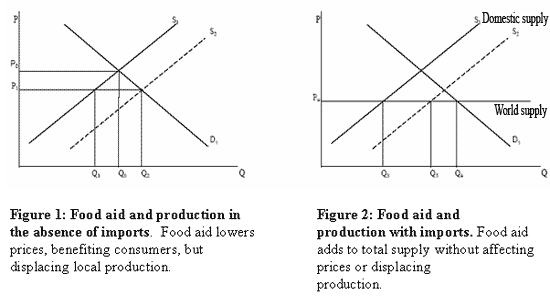I join my colleague Rachel Nugent in offering Three Cheers for CARE Decision to Forego U.S. Food Aid!U.S. food aid has a long and complicated history. Most people think of food aid as "doing good"—feeding the starving—and it is often used for this purpose. However, large amounts of food aid are sold to finance development projects, often administered by the U.S. or by NGOs. And, in the process, food aid can actually do harm.Understanding the complexities of the issue is hugely important in general and, specifically, now. Congress is mid-way through debating a new five-year Farm Bill: the House passed a Farm Bill in July that did not address calls for reform in food aid to “do best” and the Senate will take up the bill this fall. For those interested in understanding the underlying issues on food aid, read on:There are two critical issues—where it is bought and where it is sold. The U.S. government purchases food in the U.S. for food aid abroad and is required to ship it on U.S. carriers. This is obviously popular with farm states and with shipping lines, but it makes U.S. food aid much more expensive than if purchased in developing countries or shipped cost-effectively, adding as much as 30% to the cost. It can also lead to months-long delivery delays, which, during a humanitarian crisis, is ineffective. Two years ago, then USAID Administrator Andrew Natsios brought the issue of the purchase site to the forefront when he pushed for a policy that would allow USAID to allocate 25% of the food aid budget to buy food in developing countries. His proposal caused a political firestorm and ultimately was scrapped. The second issue (and the focus of the NYT article) was the impact of the sale of food aid in developing countries. As the article points out, some see food sales as helping developing countries and others see it as hurting them. From an economic perspective, the answer depends to a significant degree on the extent to which food is imported into the local economy. One situation is a country where very little food is imported and prices are determined by local supply and demand, where an increase in food aid in effect shifts out the supply of food and lowers its price (Figure 1). This can be good for consumers, particularly in a food shortage crisis—a point not emphasized in the NYT article—but it can undermine the income of local farmers. It is this situation that led to CARE's decision to phase out its receipt of food aid. The second situation is a country that produces relatively little food (Figure 2). Here the vast majority of food is imported and the local price is determined by the price of imports. In this situation, food aid simply displaces imports and does not have a significant effect on either consumption or local farm production. In effect, it saves the country's foreign exchange since it doesn't have to pay for the imported food. In this situation, an NGO that receives U.S. food aid can sell it to a local trader and the money can be used to fund local development initiatives with little effect on food markets.

So, when can food aid make sense? First is when there is a humanitarian crisis and food is urgently needed to save lives. In this situation, it would be better if the U.S. had the flexibility to buy locally so its aid money could go further to save lives. For a nation that prides itself as a moral leader, it is ironic that this may not be politically feasible. The second situation is when sales of food aid displaces imports and does not adversely affect farmer income. This is an inefficient way to finance local development projects and it provides misleading data on the financial value of foreign aid. But, under these circumstances food aid doesn't damage local production and once again, inefficiency may be the price we pay to maintain political support within the U.S. Let's hope that the combination of the Natsios proposal last year and CARE's decision this year can spark a re-thinking of U.S. food aid so that it can better serve the purposes of saving lives and financing development.
CGD blog posts reflect the views of the authors, drawing on prior research and experience in their areas of expertise.
CGD is a nonpartisan, independent organization and does not take institutional positions.






